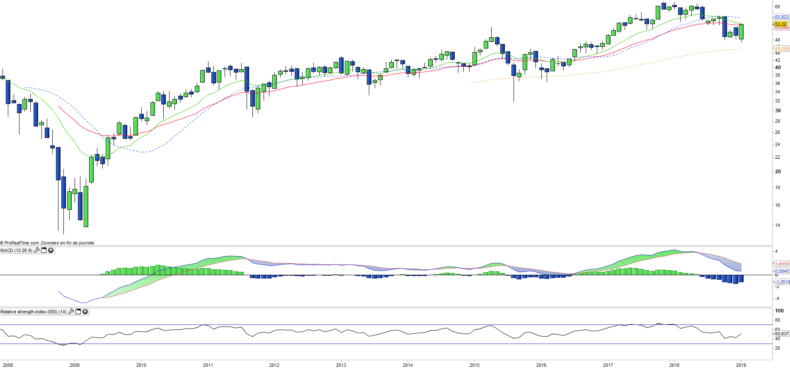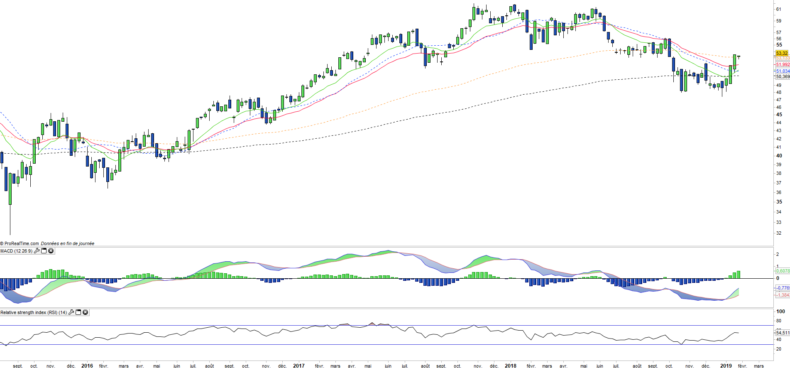Lyxor South Korea (KRW) - 30/01/19
Short Term strategy: Positive (70%) / Trend +
Long Term strategy: Positive (60%) / Trend +
Characteristics of the ETF
The KRW (Lyxor) tracker replicates the MSCI Korea index of the 114 main Korean stocks. It is therefore a rather deep index, but this ETF quoted in Euro on Euronext is very focused on technology that weighs 40% of the capitalization, but even more, a value, Samsung, weighs for 27% of the index. The other main sectors are finance (12%), consumer goods (11%), industry (8%) and mining (8%). The top 10 stocks weigh a little more than 50% or about 25% off Samsung. This tracker naturally embeds the risk related to the country's currency, the Won (which means "round" in Korean), more volatile than the reference currencies, but the big companies like Samsung realize almost all of their business in the USA, China or Europe and have ultimately limited exposure to the Won.
The ETF fee is 0.45%. The AUM of the Fund is € 150 millions.
Latest developments
After an increase of 27.2% in 2017, the KRW ETF fell by 17.3% in 2018 amid concerns about global demand, which particularly affected China and Asia, and the semiconductor slowdown in smartphone sales - particularly Apple's - and the ongoing turnaround in the auto sector. Korea is the leading manufacturer of electronic chips through its giant foundries (Hynix, Samsung) and is very sensitive to this industry.
The index rebounds in 2019 (+ 7.7%) because corporate results are finally rather reassuring with figures and prospects lowered in the short term, but without disaster announced.
In addition, semiconductor manufacturers appear rather confident in the medium term on the smartphone cycle due to the arrival of 5G. Overall for the moment more fear than harm, allowing a rebound on the sector, including Samsung and the Korean index by ricochet.
Index & components
KRW is a rather deep index (114 companies), but this ETF quoted in Euro on Euronext is very focused on technology that weighs 40% of the capitalization, but even more, a value, Samsung, weighs for 27% of the index. The other main sectors are finance (12%), consumer goods (11%), industry (8%) and mining (8%). The top 10 stocks weigh a little more than 50% or about 25% off Samsung. This tracker naturally embeds the risk related to the country's currency, the Won (which means "round" in Korean), more volatile than the reference currencies, but the big companies like Samsung realize almost all of their business in the USA, China or Europe and have ultimately limited exposure to the Won.
Korea ranks 11th in terms of GDP ($ 1400bn) between Russia and Canada; the country has experienced spectacular growth over the last 30 years, yet its strong exposure to finance and global trade hit it hard during the 2008 financial crisis. Its economy was one of the worst affected in the Asia-Pacific area, however, South Korea was also one of the first to rebound thanks to exports and fiscal stimulus. In 2017, in the context of rising tensions with North Korea, South Korea has awarded a record amount to defense, but the budget also aims to support job creation and develop the health system. The country faces structural problems such as the under-sizing of the financial market, the aging of the population, export dependence and the erosion of the country's competitiveness in the face of the Chinese economy's ramp up. The country's main sectors of activity are textiles, the steel industry, automotive manufacturing, shipbuilding and electronics. South Korea is the world's largest semiconductor producer (including major smelters). The country's trade balance has been largely in surplus since February 2012 and is expected to remain so for the next few years, while the country's main trading partners are China, Japan, the European Union and the United States.
Korea is a major player in global technology with leading players, which gives it strong growth potential but at the same time is dependent on complex geopolitical issues stemming from bad relations with Japan (because of war), China (because of its military alliance with the US) and of course North Korea, which threatens it with a nuclear strike. The index is showing resilience despite falling US technology stocks and tensions while North Korea seemingly pausing.
Monthly data
The analysis of the monthly charts shows a counter-attack in the form of a good bullish engulfing which reach EMAs13&26 which makes it possible to avoid a bearish crossovershort term. At stake is now the confirmation of this reversal pattern by the bullish breakout of the long term moving averages and the top of the great negative candlestick of October located towards 55 €. A confirmation of the figure at the end of the month is required.
Weekly data
On the weekly charts, a double-dip structure has been validated, which enabled us to cross the bearish line that has been valid since May. A reversal of medium term horizon is engaged which allowed the index to go over the MME13 and 26 and to attack the MME100 whose crossing is to be confirmed. The technical configuration is clearly improving and the uptrend is about to recover.
Theme
KRW is a UCITS ETF, listed in EUR, which seeks to replicate the MSCI Daily TR Net Emerging Markets Korea USD index (114 Korean companies)
Characteristics
| Inception date | 26/09/2006 |
| Expense ratio | 0,65% |
| Benchmark | Indice MSCI Korea |
| Issuer | Lyxor |
| Ticker | KRW |
| ISIN | FR0010361691 |
| Currency | € |
| Exchange | Euronext Paris |
| UCITS | Yes |
| EU-SD Status | Out of scope |
| Assets Under Management | 116 M€ |
| Dividend | Capitalization |
| Currency Risk | Yes |
| Number of holdings | 114 |
| Risk | 4/5 |
Country Breakdown
| South Korea | 100% |
Sector Breakdown
| Information technology | 41% |
| Financials | 12% |
| Consumer discretionary | 11% |
| Materials | 9% |
| Industrials | 8% |
| Consumer Staples | 6% |
| Communication Services | 6% |
| Others | 7% |
Top Ten Holdings
| Samsung Electronics | 27% |
| Hynix semiconductors | 5% |
| Samsung Electronics Pref | 4% |
| Posco | 3% |
| NHN Corp | 2% |
| Hyundai Motor | 2% |
| Shinhan Financial Group | 2% |
| KB Financial Group | 2% |
| Celltrion | 2% |
| LG Chem Ltd | 2% |


